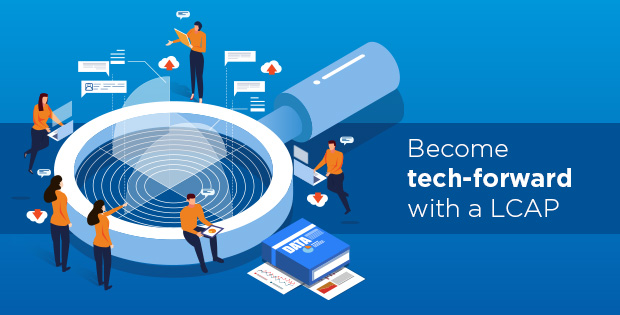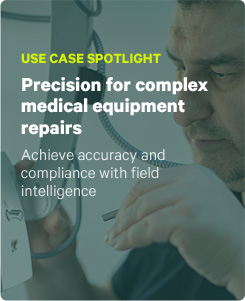
Digital transformation doesn’t have to be complicated or time-consuming.
In a recent McKinsey article: “How to become ‘tech forward’: A technology-transformation approach that works,” the authors write about reimagining, reinventing, and future-proofing business models—with technology at the crux of all three. This high-level vantage point was reached from the company’s recent survey of nearly 700 CIOs at some of the largest companies across the world.
What’s clear is that low-code application platforms meet more than just a few notable requirements of a tech-forward approach.
Step one: Reimagining the role of technology
The first step in McKinsey’s formula is reimagining the role of technology. This means adopting technology-led business and customer-facing product/platforms that eliminate silos. This is achieved through an operating model with an ingrained strategic spend allocation. To paraphrase CFO Daily News, this first step helps leaders understand where the organization is currently spending money and how spend decisions are made.
This model moves beyond simply controlling expenses to managing company spend holistically by giving finance leaders data to benchmark and analyze company performance, and allocate resources more efficiently. This goal is achieved by placing the stewardship and design of technology functions in the lap of the end-user.
To put it another way, think of the unique field service perspective across internal and external touchpoints (sales, finance, supply, operations, and of course customers, to name a few). Next, imagine putting those who know field service best in the driver’s seat by giving responsibility for planning forms and workflows. Imagine drawing from insights that ultimately result in streamlined processes and procedures. Finally, imagine leveraging this same tech-forward approach across your entire organization.
A low-code application platform requires absolutely no coding experience and captures vast amounts of data. It’s easy to use and fast, which leads to the matter of agility.
Step two: Reinventing a more flexible, agile technology delivery model
A second step toward transformative change posited by McKinsey is the need for reinventing a more flexible, agile technology delivery model by adopting what the writers refer to as “agile at scale” software technology.
As a concept, agility at scale has been gaining mad traction since the pandemic’s arrival. An excerpt from Harvard Business Review describes it like this:
“Companies that successfully scale up agile see major changes in their business. Scaling up shifts the mix of work so that the business is doing more innovation relative to routine operations….The scaling up also brings agile values and principles to business operations and support functions… leads to greater efficiency and productivity in some of the business’s big cost centers… improves operating architectures and organizational models to enhance coordination between agile teams and routine operations… the business delivers measurable improvements in outcomes—not only better financial results but also greater customer loyalty and employee engagement.”
Again, this is where a low code application platform comes to the fore. It’s scalable and integrates with existing cloud platforms and back end systems. Your customized forms and workflows can be updated and shared at a moment’s notice. Work progress can be monitored and completed in real-time. And all that data can be stored and retrieved easily to produce valuable reports for predictive and strategic planning purposes, audits, and myriad other reasons.
Step three: Future-proofing the foundation of your organization
The third and final step behind McKinsey’s worktable transformation recommendations is future-proofing the foundation of your organization.
In laymen’s terms, this is about having data built into every function, every workflow, every touchpoint, and then using advanced analytic insights to keep a competitive edge. It’s similar to finance tracking and benchmarking spending and performance data to determine budget allocation. Or sales and marketing tracking and trending the sales funnel and customer buying actions to determine what works best, how, why, and when – and adjusting as required.
Low-code application platforms are ideal for technology leaders seeking a new approach that’s, as McKinsey states, “comprehensive enough to account for the myriad interlinkages of modern technology joined at the hip with the business so that change delivers value, and is self-funded so that the scope of the change can continue to expand.”
What’s more, McKinsey’s study revealed the top two types of transformations most likely to be pursued between now and 2024 are:
- Digitizing end-user experience – 37% of CIOs
- Scaling data and analytics – 36% of CIOs
These findings are similar to the Service Council’s 2021 Service Leader Agenda Survey conducted at the start of the year. Service leaders are having to step up real-time visibility and the role of digital customer service. Thanks to the consumerization table stakes established by the likes of Amazon and Uber, immediacy of response and demands for predictive service environments are pressuring the use of more digitization. To reiterate observations from Aly Mawani, ProntoForms’ VP, Operations’, perspective: “It’s about putting the customer at the center with mobile technologies that provide telemetry of information, that deliver the ability to see what goes on in the diagnostic process, that draws in and allows for a lot more engagement between the field tech and the customer. Visibility to their service contracts, upcoming maintenance, self-serving options, age of their equipment – that’s often hard to manage. The field service industry needs to be able to give customers visibility to that data.” And low-code application platforms are the great disrupter.
How so?
The time it takes to build and deploy powerful modern apps is accelerated
Using a low-code platform means no coding experience is needed. As explained in the blog post: IT and LCAP and What You Need to Know, a citizen developer (anyone in your business who oversees a team and is looking to automate processes) can get things moving faster than going through internal hoops. The outcome is more on point with less iteration because the individual developing the app is actually closer to and understands the process that needs automating.
Automation links functions, end-to-end
With a low-code application platform in your digital transformation tool kit, field service operations can be automated from the front office staff answering and dispatching service calls to finance, supply chain and inventory management, customer and regulatory agency interactions, and what-if contingency planning.
Both technicians in the field and customers on-site or in their offices are kept in the loop with real-time information. Post-service output documents digitize the follow up process.
Data and analytics future-proof operations
All sorts of new technologies are continually hitting the market with tempting promises. But as McKinsey points out, many of these “shiny objects” have limited value because of limited partnering between technology and the business and the inability of technology to demonstrate its value within the organization. There’s a growing and demonstrable view in field service that data analytics is a critical business capability.
Curious to discover how ProntoForms is the cornerstone for tech-forward companies like Johnson Controls, KONE, and Halliburton? We’d love to show you! Book a demo today to gain valuable information on how to future-proof your organization.



